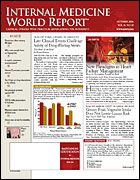Publication
Article
Internal Medicine World Report
The Lessons of the E coli O157: H7 Outbreak
Author(s):
How to Minimize Future Risks
With the outbreak of entero-hemorrhagic Escherichia coli across the country in early September, 23 states were reporting contamination from bagged spinach consumption, but neither the FDA nor the Centers for Disease Control and Prevention (CDC) have yet determined how the contamination occurred.
E coli
By September 24, 2006, the CDC reported that 173 people in 25 states had been infected with O157:H7. Most of the reported cases occurred in adults, and the only documented fatality involved an adult in Wisconsin. The outbreak was linked to spinach grown in 3 counties in California (Monterey, San Benito, and Santa Clara).
E coli
Physicians who see a patient who is complaining of bloody diarrhea with significant cramping should be concerned about the possibility of infection, advises Jeffrey P. Davis, MD, of the Wisconsin Division of Public Health, Madison. Clinicians should order stool cultures in suspicious patients.
“The culture gives the lab the opportunity to do all the specific typing,” Dr Davis explained. “That information is essential.”
E coli
E coli
You should also report documented cases, so that health officials can track outbreaks. Contact your local health department if any of your patients is infected with . “The reporting of infections is really essential,” he stressed.
E coli
Although patients may feel uncomfortable when they have bloody diarrhea caused by , it is the hemolytic uremic syndrome (HUS) that occasionally accompanies the diarrhea that is responsible for the greatest morbidity and mortality.
The most common cause of acute renal failure in children, HUS is characterized by the triad of acute renal failure, microangiopathic hemolytic anemia, and low platelet count. Patients with these features, along with fever and neurologic symptoms, are considered to have the related disorder—thrombotic thrombocytopenic purpura.
E coli
E coli
Some cases of this life-threatening condition have been associated with the O157:H7 infection. Dr Davis urges clinicians to keep patients with well hydrated and monitor the platelet count if they suspect impending HUS.
E coli
E coli
The current outbreak of has being contained, but other outbreaks are likely. In the past, had been associated with hamburgers from fast food restaurants, but it is now becoming more prevalent in fresh produce.
“There have been 20 outbreaks on record where the illness has been associated with leafy green vegetables. It certainly begs the question of what can be done [to keep the food supply safe],” said Dr Davis.
Contaminated water has been cited as a possible cause of this current outbreak; even washing spinach after removing it from the bag will not help prevent disease.
Cooking food to 160°F is the only way to kill the organism, according to Dr Davis.
The CDC tracks outbreaks via PulseNet, www.cdc.gov/pulsenet, an online-based national network of food regulatory agency laboratories. Dr Davis said that officials in Wisconsin first noticed the pattern of E coli cases as reported on this site, which made them realize quickly that an outbreak was occurring.
Stephen Weber, MD, hospital epidemiologist at the University of Chicago, pointed out that epidemiologists quickly realized that an outbreak was occurring, and through a collaborative effort, they were able to pinpoint the source quickly. Without the immediate response, the outcome could have been much worse. “You’re seeing what can happen when smart people in public health can collaborate and do what they need to do,” Dr Weber said.
Key points
E coli
Suspect the possibility of infection in a patient who is complaining of bloody diarrhea with significant cramping.
Order stool cultures in suspicious cases.
E coli
Contact your local health department to report of any patient infected with .
Hemolytic uremic syndrome can accompany bloody diarrhea and is the cause of morbidity in children. It involves the triad of acute renal failure, microangiopathic hemolytic anemia, and low platelet count.





